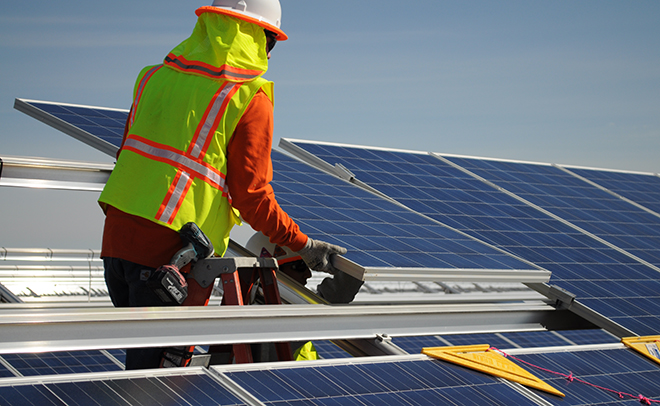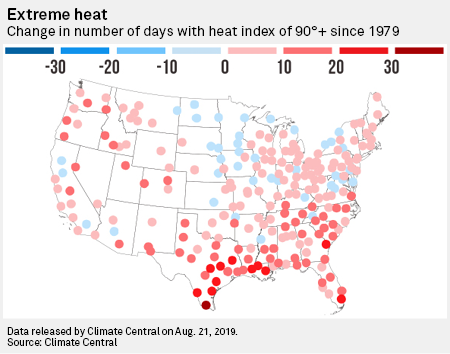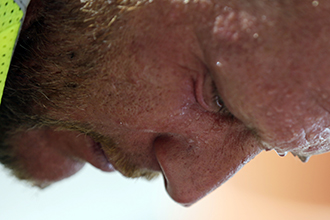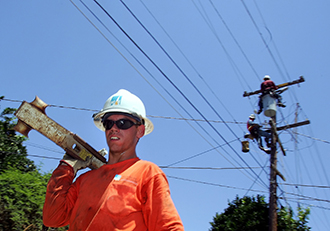
A construction worker for Cupertino Electric installs a panel on a solar array in Southern California. Source: Cupertino Electric Inc.
Some parts of the U.S. have seen an uptick in the average number of hot days in recent decades. That trend is expected to continue due to global warming, which will put more outdoor utility workers at risk of heat-related illness and could hamper their overall productivity levels, according to experts and recent studies.
The average number of days with heat index temperatures of 90 degrees Fahrenheit or higher climbed over the past four decades in 198 U.S. locations, Climate Central found in an Aug. 21 report. Moreover, since 1979, nearly a dozen U.S. cities have experienced an increase in the number of so-called danger days in which the heat index was 105 degrees or hotter.
Going forward, the average number of days with a heat index above 90 degrees in the U.S. is projected to increase from a historic average of 81 days per year to 127 days per year by mid-century if the world does not act quickly to limit greenhouse gas emissions levels, the Union of Concerned Scientists, or UCS, found in a July report.
Scientists have indicated that a significant build-out in renewables and low-carbon technologies will be needed to achieve the goals of the Paris Agreement on climate change, but some of the prime locations for those projects are in areas that could be hardest hit by a climbing heat index.
 For example, the UCS report predicted that the number of days with a heat index above 100 degrees will triple in Texas under a no-climate action scenario. Texas has the most planned wind and solar generation capacity in the U.S., according to S&P Global Market Intelligence data. And Texas is part of the Sunbelt, which UCS has suggested could be the hardest hit part of the nation.
For example, the UCS report predicted that the number of days with a heat index above 100 degrees will triple in Texas under a no-climate action scenario. Texas has the most planned wind and solar generation capacity in the U.S., according to S&P Global Market Intelligence data. And Texas is part of the Sunbelt, which UCS has suggested could be the hardest hit part of the nation.
“Were we to take no action to reduce heat-trapping emissions, the Sunbelt, stretching from the Carolinas across the South to Southern California, would see the most dramatic and life-threatening jump in the frequency of high heat index days of all regions of the United States,” the UCS report found.
An analysis of Market Intelligence data shows that four of the 10 states with the most planned wind and solar generation capacity are in the Sunbelt. In addition to Texas, the other states are California, New Mexico, and Nevada.
The heat index is a combination of air temperature and humidity that effectively gauges what the temperature feels like to your body. The Occupational Safety and Health Administration recommends employers begin taking actions to mitigate employee heat exposure when the index nears 91 degrees.
Prolonged exposure to higher temperatures in direct sunlight without proper hydration, training, acclimatization, dietary habits and work breaks in shaded areas can lead to heat exhaustion and potentially heat stroke, which can prove fatal. Heat stress killed 815 U.S. workers and seriously injured more than 70,000 workers from 1992 through 2017, according to the Bureau of Labor Statistics.
When it comes to outdoor workers installing solar arrays in the California deserts, for example, “it’s constantly an ongoing effort to keep these guys safe when it comes to extreme heat,” said Ivan De Herrera, the safety director of the Los Angeles Local Union 11 of the International Brotherhood of Electrical Workers.

Hot days reduce productivity
Under an extreme global warming scenario, almost two billion labor hours are projected to be lost annually by 2090 from the impacts of temperature extremes, costing an estimated $160 billion in lost wages, according to the U.S. government’s Fourth National Climate Assessment.
For Rosendin Electric, Inc., an electrical construction contractor on a variety of projects including transmission and distribution lines and wind and solar, training employees on proper hydration, diet, warning signs, as well as giving new employees time to get acclimated to the job and weather is a priority, said Shayne Stevens, Rosendin senior corporate safety director.
But the company also is aware that the performance of their employees may sometimes be subpar when temperatures skyrocket.

Perspiration collects on construction worker David Macmullen’s face in the afternoon sun in Philadelphia during a July 2012 excessive multiple-day heatwave across a number of mid-Atlantic and Northeastern states. Source: Associated Press
“It’s one of those things where definitely on hotter days you may not quite have the energy that you normally would on a nice day,” he said. “In very, very hot temperatures, obviously we’re going to need more breaks, more time to get fluids in our employees and making sure they’re drinking plenty of water as well.”
OSHA currently does not have heat exposure-specific requirements but it can issue citations to employers under the part of the law that requires employers to maintain a safe workplace even in the absence of regulations and standards. More than 100 health, labor, consumer advocate and other groups including IBEW, Public Citizen and the Union of Concerned Scientists urged OSHA in an April letter to promulgate and enforce a heat standard.
They cited the BLS heat-related injury and death statistics and argued that “a federal heat-stress standard would help to prevent countless illnesses and deaths caused by heat, benefiting workers and employers alike.”
Many of those same groups back legislation that U.S Reps. Raúl Grijalva, D-Ariz., and Judy Chu, D-Calif., introduced in July to require OSHA to create heat-related workplace standards. The bill, H.R. 3668, thus far has only Democratic co-sponsors.
California, Minnesota, and Washington, as well as the U.S. military, have standards for heat exposure and some construction companies have opted to apply California’s standards across all of their U.S. operations. California’s standard applies to outdoor workers in construction, agriculture, landscaping, and oil and gas extraction industries and has additional procedures for when temperatures exceed 95 degrees, including requiring employees to have access to nearby fresh, cool water free of charge.
Keeping workers safe
Most solar construction projects undertaken by Cupertino Electric Inc. involve 200 to 300 people working under a relentless sun in remote desert areas for months at a time. Working on a reflective surface and on a solar panel that inherently uses heat to produce electricity means construction companies may need to take extra steps to help workers stave off heat exhaustion. The typical solar panel is 20 degrees to 30 degrees hotter than the ambient temperature, said Tim Jensen of Cupertino.
For starters, Cupertino tries to hire new employees in the milder season months to both allow their muscles and body to acclimate to working conditions, which typically takes about two months, Jensen said.

A utility worker sweats as he works during a 2006 heatwave in San Jose, Calif., to help replace a burned out transformer. Source: Associated Press
The company also encourages its employees to wear breathable cotton, cover as much skin as they can, and wear the high-visibility vests as well as shade covers on the back of hard hats to protect them from the sun. Cupertino also has a buddy system and trains employees to notice signs of heat exhaustion.
“If a guy’s face is getting flushed … we’ve got a system in place where we can react to that” by getting them in shade under a tent or in a truck or mobile-office with the air conditioning running and get those people hydrated. The company buys ice chests by the hundreds and keeps them stocked with ice and water bottles and it adjusts the work start schedule to better align with shifting daylight hours.
Some companies post urine color charts above urinals to help employees identify when they are becoming dehydrated, and companies often recommend employees pack light lunches with plenty of fruit rather than heavy meals. Sometimes supervisors will come around and hand water bottles to each person on a team and stand around and talk while they finish the bottle, or hand out electrolyte popsicles.
“The bottom line is making sure people go home each day without being injured,” said Marty Rouse, Rosendin’s vice president of safety. In the case of heat exhaustion, “if you’re not taking care of your employees when they’re on the job site … and their body is totally depleted of water and then they go home, drink a couple of beers, and go to bed, their systems can literally start shutting down when they’re sleeping.”
https://www.spglobal.com/marketintelligence/en/news-insights/latest-news-headlines/53750975
